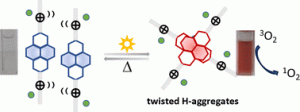Unprecedented light induced aggregation of cationic 1,4,5,8-naphthalenediimide amphiphiles
Our article is available to read at J. Mater. Chem. C.
 Naphthalenediimide amphiphiles (NDI-as) with quaternary ammonium groups (DC4, DaP, and DaO) display unprecedented UV light-induced aggregation in solutions of water, acetonitrile and THF. Light-induced aggregation brings significant spectral modification by which unusual absorption band distribution is assigned to H-type aggregates. Such aggregation can be reversibly broken by heating and reassembled by photoirradiation. The irradiation/heating cycles that provoke assembly/disassembly process can be confirmed by 1H-NMR spectroscopy. The possibility of a chemically promoted aggregation by or radical anion either anion–π interaction may be ruled out by UV-Vis, EPR and electrochemistry measurements. These photoinduced aggregates can sensitize dissolved O2 to produce singlet oxygen, a surprising observation when it comes to sensitization efficiency for dyes as aggregation usually decreases sensitization yield. Laser-induced luminescence measurements corroborate the existence of monomeric and aggregate forms, as well as confirm triplet states as phosphorescence was detected, being particularly intense in concentrated THF solutions.
Naphthalenediimide amphiphiles (NDI-as) with quaternary ammonium groups (DC4, DaP, and DaO) display unprecedented UV light-induced aggregation in solutions of water, acetonitrile and THF. Light-induced aggregation brings significant spectral modification by which unusual absorption band distribution is assigned to H-type aggregates. Such aggregation can be reversibly broken by heating and reassembled by photoirradiation. The irradiation/heating cycles that provoke assembly/disassembly process can be confirmed by 1H-NMR spectroscopy. The possibility of a chemically promoted aggregation by or radical anion either anion–π interaction may be ruled out by UV-Vis, EPR and electrochemistry measurements. These photoinduced aggregates can sensitize dissolved O2 to produce singlet oxygen, a surprising observation when it comes to sensitization efficiency for dyes as aggregation usually decreases sensitization yield. Laser-induced luminescence measurements corroborate the existence of monomeric and aggregate forms, as well as confirm triplet states as phosphorescence was detected, being particularly intense in concentrated THF solutions.